The Benefits of Dental Implants
Durability and Longevity: Implants are designed to be a permanent solution. With proper care, they can last a lifetime, unlike dentures or bridges, which may need to be replaced every 5-10 years.
Improved Oral Health: Unlike bridges, which require adjacent teeth to be ground down for support, implants do not affect neighboring teeth. This preserves more of your natural tooth structure.
Enhanced Appearance and Confidence: Implants look and feel like natural teeth, improving your smile and boosting self-confidence. They also prevent the sunken appearance that can result from bone loss after tooth loss.
Better Functionality: Because implants are securely anchored in the jawbone, they provide better chewing efficiency compared to traditional dentures, allowing you to eat a wider variety of foods without discomfort or worry.
Bone Preservation: When a tooth is lost, the surrounding bone begins to deteriorate due to a lack of stimulation. Implants provide the necessary stimulation to maintain bone mass, preventing facial sagging and jawbone loss over time.
The Implant Procedure
Initial Consultation: The process begins with a thorough examination, including X-rays and possibly 3D imaging to assess the condition of the jawbone and determine if the patient is a good candidate for implants.
Bone Grafting (if necessary): In cases where the jawbone is not thick enough or has deteriorated, a bone graft may be necessary to provide a solid foundation for the implant.
Surgical Placement: During the surgery, the implant is inserted into the jawbone. Over the next few months, the implant fuses with the bone, creating a stable base for the new tooth.
Placement of the Abutment and Crown: Once the implant has fully integrated with the bone, an abutment is placed on top, followed by a custom-made crown. The result is a tooth that looks, feels, and functions just like a natural one.
Advances in Implant Technology
Recent technological advancements have made dental implants more accessible and effective than ever. Some notable innovations include:
3D Imaging and Printing: These technologies allow for precise planning and customization of implants, ensuring a perfect fit for each patient.
Zirconia Implants: While titanium is the most commonly used material, zirconia implants are gaining popularity due to their natural white color and high biocompatibility.
Immediate Load Implants: Traditionally, patients had to wait several months for the implant to fuse with the bone before receiving the final restoration. Immediate load implants allow for a temporary crown to be placed on the same day, speeding up the process.
Conclusion
Dental implants are a game-changer for individuals suffering from tooth loss, offering unparalleled durability, functionality, and aesthetic benefits. As technology continues to evolve, implants will likely become even more advanced, making them the go-to solution for restoring smiles. If you’re considering dental implants, consult with a qualified dentist to determine if they are the right option for you.


